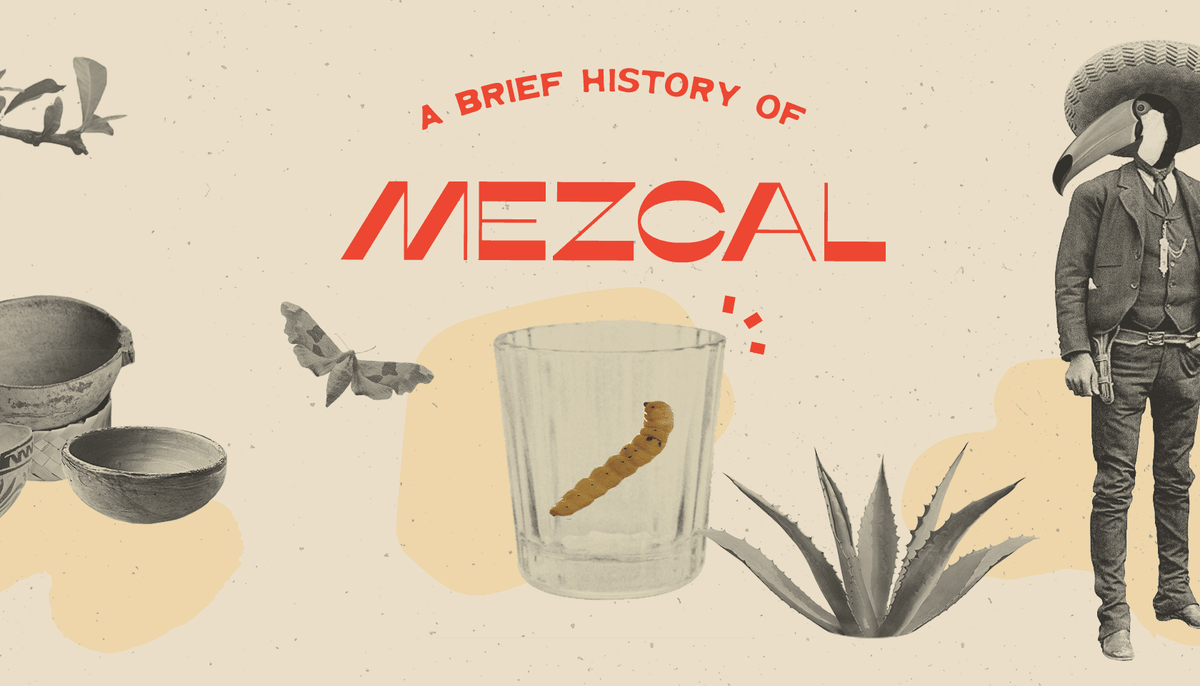
A Brief History Of Mezcal
|
|
Time to read 4 min
|
|
Time to read 4 min
Mezcal is taking the world by storm-- yet, most people still don't know the difference between Mezcal and Tequila much less where this amazing Mexican liquid comes from. So, we decided to make a video about it. If you don't know, now you know. Cheers Mezcalistas.
Mezcal! Is it the same as Tequila? Does it make you trip? Why is there a worm in it? And what does it have to do with Frida Kahlo’s eyebrows?
1) Yes and no; 2) No, that’s mescaline, silly; 3) Because Mad Men, and 4) You’ll see. Also, there’s only one superhero that has a better origin story than Mezcal.
Hi, I’m Krista Curry, and this is A Brief History of Mezcal. Subscribe to our channel and punch that bell button to stay in the loop with all things boozy! Now, let’s do this!
While the word ‘tequila’ has a naughty, boob-related origin, Mezcal literally means ‘over-cooked agave.’ So, just like with Brandy, which means ‘burned wine,’ these guys didn’t spend much time on spitballing the name.
Mezcal is made from the heart of the agave plant. There are more than 30 species of agave used to produce Mezcal, the most popular being Agave Espadin, which is the source of 90% of Mezcal. By the way: If you make Mezcal from the Blue Agave and you do it in the state of Jalisco, you get Tequila.
Or, as the famous adage goes: “All Tequila is Mezcal, but not all Mezcal is Tequila.”
The Mezcaleros traditionally roast the plant in fiery underground pits, crush it, and mix it with water. When the fermentation is complete, they move the stuff into copper pot stills where the small-batch distillation process happens. Mezcal is in the state of Oaxaca, where 60% of the Spirit is produced.
That’s also where Frida Kahlo’s mom was born, so you have to thank the region both for Mezcal and the most badass eyebrows in history.
The origin story of Mezcal puts to shame all superheroes, except perhaps Teenage Mutant Ninja Turtles, because that shit is rad.
See, the agave plant used to be sacred in Mexico and was used in religious rituals. The myth says a lightning bolt struck an agave plant, cooking and releasing the milky juice everyone called Pulque. It was considered to be the elixir of gods, and when the Spanish conquistadors came bothering the locals, they wanted a sip of that.
The invaders were, however, used to harder stuff, and when they ran out of European liquor, they had to find something with enough ABV to give them a sufficient buzz. No one knows who, but one of these European imbibers decided to take this sacred plant and distill it. ¡Aqui tienes!, Mezcal!
For a long time, Mezcal remained a well-kept secret of Mexico, only made in small batches. While Tequila was conquering the world – one Margarita at a time – Mezcal was mostly known as ‘aguardiente’ or ‘firewater’, sold in cantinas with a worm. We’ll talk about worms later.
Plus, Tequila was named the national drink of Mexico in the 1970s, putting the final nail in all Mezcal’s aspirations of becoming the Big Honcho. It’s like saying Paul McCartney is the G.O.A.T., but completely forgetting The Beatles. Not cool, Mexico!
Well, give it to an industrious gringo to shoot something to the stratosphere. Meet Ron Cooper, an artist from Ojai, California. He stumbled upon Oaxaca and Mezcal when traveling, and fell in love with both.
He established Del Maguey in the 90s and started making fine artisanal Mezcal. He introduced the mythical Spirit to the United States and the rest of the world. And people loved it! If there were around 360 distilleries in Oaxaca in 1892, there are over 2,000 today.
And while a lot of people feel Tequilas taste the same now, Mezcal offers a rich diversity of profiles, still sticking to small-batch production. Mexico made over 5 million liters of Mezcal in 2018.
Okay, but what about the worm? You know how cowboys used to down a shot of Mezcal to prove they were real hombres? What’s up with that?
Well, we actually covered this question in one of our previous videos, but here’s the gist: it’s all a marketing ploy from the 1940s that wanted to persuade people to switch from Tequila to Mezcal because the worm allegedly made it taste better.
Except: It’s not a worm, it’s a moth larva that lives in an agave plant, and Hollywood lied to you. Also, please don’t drown insects in your booze. Gross!
In the States, it’s served neat in a small glass, while the Mexicans put it in a hollowed shell of a calabash fruit. Some people add a slice of orange and a salty larva-based powder, but if you’re trying a more premium Mezcal with layers of flavors, maybe just skip all that.
If you want something genuinely Mexican, make yourself an Oaxaca Old Fashioned that blends Mezcal, Tequila, agave nectar, and Angostura bitters. Senor Sinatra would’ve loved it!
Perhaps you want to go completely bonkers and make yourself an El Camino, which calls for a mix of Mezcal, Rye Whiskey, Benedictine, and bitters. I'm dizzy just thinking about it.
Or, add sweet vermouth, apple brandy, Fernet-Branca, and Maraschino to your Mezcal, because why the hell not? They call this bad boy "All Jacked Up".
That’s it, boys and girls. You now know what Mezcal is. Enjoy it responsibly, stay away from larvae, and don’t forget to subscribe to our channel. Bye!